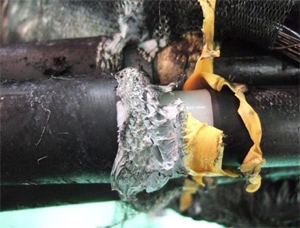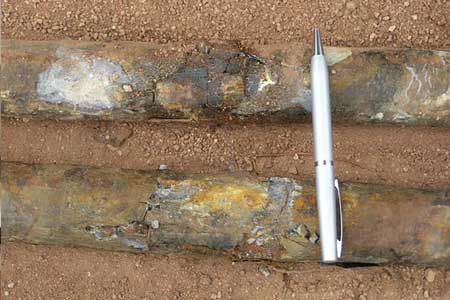
|
|
| home | contact | team t&d | group websites | markets | exports | blog |
 |
|
When All Else Fails....Blame The Jointer
By Chris Dodds on 3rd February, 2015

Not So. Think Twice.
Crass attitudes lacking discrimination can sully personal and business reputations. So, a few words in defence of our cable jointers.
When a high voltage power cable fails during normal operational service or during pressure testing prior to energisation, the clamour to play the blame game starts. If the HV cable failure is located to a cable joint or cable termination the first shout is often directed at the cable jointer.
T&D believe a fairer approach should be adopted before leaping to often a false condemnation of skilled high voltage cable jointers work.
Particular attention should be paid to ensuring the correct cable joint or cable termination, whether it be Heat Shrink or Cold Shrink jointing technology, has been specified. With a plethora of different cable types and cable constructions in existence at high voltage it is obvious due care should be taken to ensuring the cable joint or cable termination is designed and type tested to suit the cable it is to be installed onto.
Specialist High Voltage Electrical Equipment Distributors, such as Thorne & Derrick UK, have been established since the mid 1980's and have vast experience and technical know-how in specifying and supplying the correct joint or termination for the job, whether it be 11kV or 33kV.
Pic : 33kV Single Core XLPE Heat Shrink Through Joint Failure

Contractors should ensure where possible that prospective suppliers of high voltage cable joints and cable terminations are provided with correct cable specifications and details of the installation environment.
For instance, if the cable joint or cable termination is being installed on HV cables in hazardous areas with potentially explosive atmospheres then 3M Cold Shrink would be preferred as no "hot-working" is required. Inflammable gasses, air and naked flames do not mix well when jointing cables offshore.
If a vertical HV cable joint needs to be done, choose SPS Heat Shrink cable joints due to the difficulty of pouring and curing resin based cable joints on a vertical plane.
If a cable cannot be identified prior to cable jointing, then select a SPS Universal 11kV cable joint suitable for straight or transition cable jointing of XLPE and PILC with mechanical shearbolt connectors to handle any type conductor the jointer may encounter.
Pic : PILC Paper Lead Cable With Lead Sheath Failure Allowing Moisture Into The Cable

Images via HVS
If jointing FP cables, naturally install a fire resistance type cable joint to preserve the cable system integrity. Often, jointing or terminating cables in industrial areas, such as refineries, XLPE cables may be lead sheathed (hydro carbon barrier) - in this case install 3M Hydro Carbon resistant cable joints to prevent long-term cable joint degradation and possible future failures.
In short, the industry should avoid building in future failure risks to LV or HV cable systems by under-specifying the cable joint or cable termination. And then blaming the Jointer.
If in doubt, contact T&D.
Further Reading :
Case 1 - An 11kV 3 Core Transition Cable Joint Which Was Audibly Discharging
Case 2 - High Voltage Cable Joint Failure On 11kV Trifurcating Transition Joint
Case 3 - An 11kV Heat Shrink Transition Cable Joint Failure
Case 4 - Problems Of Cable Joint Earth Continuity On Low Voltage Feeder Cable
Case 5 - "Buzzing" 11kV Cable Box Terminations On XLPE 3 Core Cables
Video : Run For Your Life! A Fireball. Exploding pavement. Ground quakes. Building shakes. Shooting flames. The following Video highlights a few possible outcomes of a cable failure.
Category: HV Cable Jointing & Terminating
Sort by Category:
- #ThrowBackThursday
- 3M Scotch Tapes
- ABB Power Products
- Business
- Cable Accessories
- Cable Cleats & Cable Ties
- Cable Containment LV HV
- Cable Crimping & Cutting Tools
- Cable Jointer Training Courses
- Cable Jointing - PhotoBlog
- Cable Labelling & Marking
- Cable Laying & Cable Pulling
- Cable Transits & Duct Sealing
- Company Updates
- Earthing & Lightning Protection
- Electrical Equipment HV
- Electrical Equipment LV
- Electrical Safety & Arc Flash
- Exports
- Flexible Conduit Cable Management
- Hazardous Area Electricals & Lighting
- HV Cable Jointing & Terminating
- LV Cable Jointing & Terminating
- Nexans Euromold Cable Accessories
- Plugs & Sockets
- Power Distribution & Feeder Pillars
- Prysmian FP Cables
- PV Solar Farms
- Rail
- T&D History Blog
- Terms & Conditions of Sale & Purchase
Tweets by @ThorneanDerrick




























